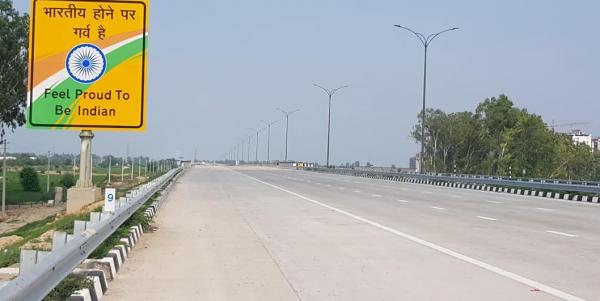
The 130 Km long Eastern Peripheral Expressway (EPE), also called National Expressway-2 (NE-2), brings heart-warming good news to the residents of Delhi and NCR region. The six lanes provides a picturesque, hassle-free travel in absolutely ‘green’ surrounding.
It is proclaimed as the first Indian “Smart and Green Expressway”. We found out that these claims are not exaggerated but EPE truly deserves this tag. It holds the unique distinction of being a project in the Indian ‘Roads and Highways’ Government sector, which was completed way before the stipulated timelines. It was completed in an Indian record of 500 days vis-a-vis the sanctioned 910 days.
Kudos to the Ministry of Road Transport and Highways (MoRTH), National Highway Authority of India (NHAI), and the Contractors for this commendable achievement in public service.
The future road and other construction projects shall positively be measured for their performance against the benchmark established by the EPE. And before-time or on-time completion shall be considered a norm, rather than an exception!
Why was the EPE required?
An absolutely appropriate question about this ₹ 11,000 Crore project.
Consider the fact that all major cities located on the Highways, either have a bypass or flyovers, enabling the non-destined traffic to circumvent the city. However, such a viable option was not available for Delhi. On the ground, this translates into more than 50,000 non-destined vehicles plying through Delhi, resulting in traffic congestion and massive air pollution. As per the EPCA Study, such a large number of non-destined vehicles contributed, up to, 28% of the air pollution!
This is also aggravated by the fact that congestion by default means slow-moving and stop-and-go traffic. We all are aware of the fact that a vehicle produces maximum pollution when the engine is running idle, say, while you are waiting for the light to turn green at a junction. Taking note of these facts, the Honourable Supreme Court directed the NHAI for the creation of EPE.
Why shall we embark on the EPE?
EPE is a toll road, it costs to use it. For using the EPE one would have to shell out money for the toll, ranging from ₹ 1.38 per km for cars to ₹ 8.95 for the oversized vehicles. Is it worth to pay such a high toll to use EPE?
First and foremost, by using EPE you do not add to the pollution and congestion of Delhi. Secondly, as per the surveys, driving on the highway improves the fuel efficiency between 10 to 40%. Considering an average saving of 25% and with the Delhi Petrol price of about ₹ 76, this amounts to a saving of ₹ 19 per litre. Therefore, the saving in fuel shall more-or-less negate the toll charges.
It also enables you to literally, zoom across the entire stretch at 120 Kmph, the top speed for which EPE is designed, thus reducing exhaustion levels for you and your vehicle. Add to it that the commercial vehicles save on the MCD Toll Tax. Two-wheelers and other slow-moving traffic are not allowed, therefore, you have the peace of mind and the driving pleasure is absolutely complimentary!
Typically, if you do not have any need to enter Delhi and are headed to or from Punjab, Haryana, Jammu and Kashmir, Uttar Pradesh, Uttarakhand, and Rajasthan, then EPE shall be your choice to travel.
Starting at the Km 36.08 of NH-1 at Kundli, the EPE ends at Km 64.33 of NH-2 at Palwal. It also has various other exits enabling circumventing Delhi and reaching your destination early. By all means, you may even prefer to undertake the EPE, to avoid the Delhi Traffic altogether, even if you are headed towards Ghaziabad, Noida, for example.
India’s first Green Expressway
Around 2.5 lakh trees planted along EPE aided with drip irrigation make it flush with greenery. That converts to around 1850 trees per km! Additionally, Rain harvesting mechanism is installed at every 500 metres on both the sides. That surely makes it green all the way.
Moreover, 40 colourful fountains and 36 replicas of famous monuments adorn the EPE. Thereby, breaking the monotony of the travel and complimenting the landscape.
Even on the lighting front, eight 4 Mega Watt Solar Power plants render the power generation ‘green’. These solar plants generate enough electricity to light it up end-to-end.
India’s first Smart Expressway
Contemporary state-of-the-art technology is utilised to make the EPE a truly Smart Expressway. Right from weigh-in-motion technology, even before the entry, to disallow any overweight vehicles. The fibre-optic network set-up allows real-time incident management.
Moreover, other technologies like Highway Traffic Management System (HTMS) with Variable Message Signs (VMS) CCTV, Video Incident Detection System (VIDS), Pavement Management Systems, Warning Devices, etc. also support the claim of a smart expressway.
Do not even think about getting too ambitious on the accelerator! For curbing over speeding and to penalise the drivers, EPE is equipped with auto-challan. Beware! You are under the eyes of cameras installed every two km to record and register the violations.
EPE in Summary
It may be, safely, termed as a possible trendsetter in the sector of large-scale Indian Government projects. Wherein, the before time completion is commendable. Moreover, the entire project is designed and delivered keeping the ‘core ethos’ of environmental friendliness.
Do share your experiences and tips from your travel via India’s first “Smart and Green” expressway.


